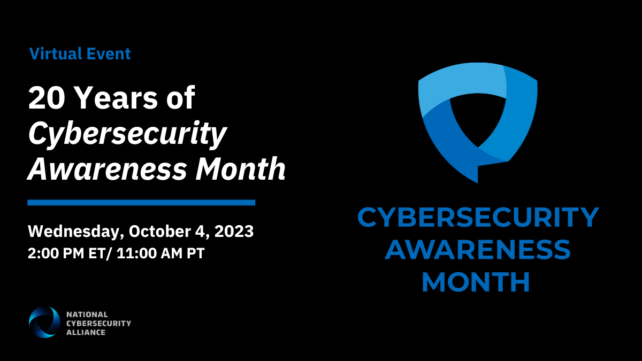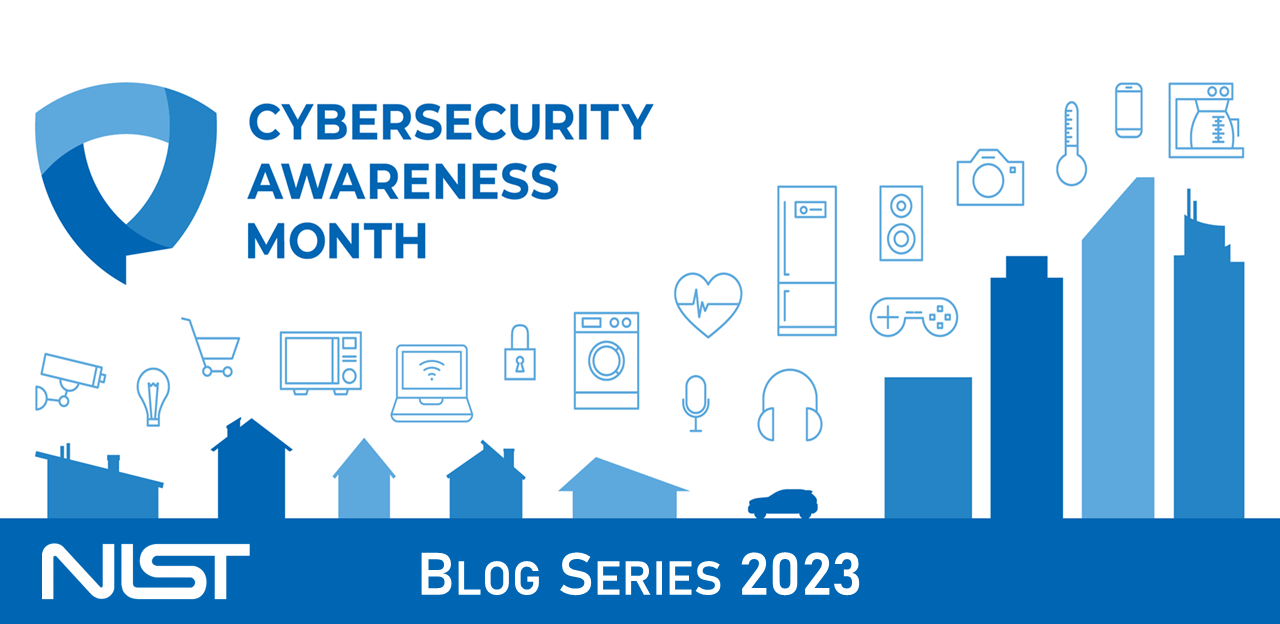To promote Cybersecurity Awareness Month, engage leaders and start security education during onboarding. Follow up with continuous training, evaluations, and positive communication.
Additionally, consider cybersecurity training programs, phishing simulations, security awareness campaigns, regular updates, password guidelines, and policies. Ensuring employees are well-informed can significantly reduce cyber attack breaches caused by human error and protect against potential attackers. Measures such as password management, software updates, email safety, firewalls, data backup, and VPN usage are also crucial for maintaining strong cybersecurity.
Consider implementing security-related activities, such as capture the flag events, security trivia, theater, escape rooms, scavenger hunts, and puzzles, to engage and educate employees during Cybersecurity Awareness Month. Promoting awareness and active participation is essential for building a cybersecurity-conscious culture in the workplace.
Why Cybersecurity Awareness Month Matters

Cybersecurity Awareness Month is an essential initiative to underline the significance of online safety and the potential impact of cybersecurity threats. In the digital age, where cyber incidents are becoming increasingly prevalent, it is crucial to educate individuals about the importance of maintaining secure online practices. This month serves as a reminder to individuals, businesses, and organizations to prioritize cybersecurity awareness and take proactive measures to safeguard their digital assets.
Impact Of Cybersecurity Threats
Cyber threats can have detrimental effects on individuals, businesses, and the economy as a whole. The impact of cybersecurity threats extends beyond financial losses and can result in reputational damage, data breaches, and disruption of critical operations. It is imperative to comprehend the severity of these threats and actively work towards mitigating potential risks.
Importance Of Online Safety
Ensuring online safety is paramount in protecting sensitive information and mitigating the risk of cyber attacks. By promoting the importance of online safety, individuals are empowered to adopt secure practices such as using strong and unique passwords, regularly updating software, and exercising caution when interacting with online content. Emphasizing online safety helps to foster a cybersecurity-conscious culture and reduces vulnerabilities to potential cyber threats.

Credit: staysafeonline.org
Promoting A Cybersecurity-conscious Culture
To promote a cybersecurity-conscious culture, consider cybersecurity training programs, phishing simulations, and regular security updates. Encourage password hygiene and adherence to cybersecurity policies and guidelines. By engaging employees in security awareness campaigns and maintaining positive communication, you can raise awareness and mitigate human error.
Get Leaders On Board
Getting the leadership team on board with cybersecurity initiatives is crucial to promoting a cybersecurity-conscious culture in your organization. Leaders set the tone for the entire company and their support and commitment can make a significant impact. Encourage management to actively participate in cybersecurity awareness initiatives and lead by example.
They can demonstrate their commitment by attending training sessions, discussing cybersecurity in staff meetings, and emphasizing the importance of online safety and best practices. When leaders prioritize cybersecurity, it sends a clear message to employees that this is a top priority.
Educate During Onboarding
Integrating cybersecurity awareness into the onboarding process is a great way to ensure that new employees are immediately equipped with the knowledge and skills to protect themselves and the company against cyber threats. During the onboarding process, provide new hires with cybersecurity training materials, policies, and guidelines. This education can include information on recognizing phishing attempts, creating strong passwords, and understanding the importance of updating software regularly. By starting cybersecurity education from day one, you establish a culture of security from the very beginning.
Regular Training And Evaluations
Cybersecurity training should not be a one-time event. It should be an ongoing effort to ensure that employees stay informed about the latest threats and best practices. Conduct regular training sessions to refresh their knowledge and introduce new concepts. Training can be conducted through interactive workshops, online courses, or even gamified learning platforms.
Additionally, consider conducting periodic evaluations to assess employees’ understanding of cybersecurity concepts and identify areas for improvement. This evaluation can be done through quizzes, tests, or simulated phishing exercises. Regular training and evaluations keep cybersecurity awareness at the forefront of employees’ minds and help reinforce a culture of security.
By implementing these strategies, you can promote a cybersecurity-conscious culture in your organization. Remember to get leaders on board, educate during onboarding, and conduct regular training and evaluations. These efforts will help create a workforce that is knowledgeable, vigilant, and proactive in protecting against cyber threats.
Raising Awareness Among Employees
During Cybersecurity Awareness Month, consider implementing cybersecurity training programs, phishing simulation exercises, and security awareness campaigns to raise awareness among employees. Regular security updates, password hygiene guidelines, and cybersecurity policies can help promote a culture of cybersecurity-consciousness within the organization.
Cybersecurity Training Programs
Implementing cybersecurity training programs is crucial in raising awareness among employees. By providing comprehensive training sessions, employees can gain a deeper understanding of the potential risks and threats they may encounter in their daily work.
These training programs should cover topics such as how to identify phishing emails, how to create strong passwords, and how to protect sensitive information. With the knowledge gained from these programs, employees can become proactive in safeguarding themselves and the company against cyber attacks.
Phishing Simulation Exercises
Phishing emails continue to be a prevalent threat in the cybersecurity landscape. Conducting phishing simulation exercises can help employees recognize and respond appropriately to suspicious emails. These exercises involve sending mock phishing emails to employees and tracking their responses.
By analyzing the results, organizations can identify areas for improvement and provide targeted training to those who need it. Regular phishing simulations will ensure that employees are constantly aware of the tactics used by cybercriminals and are equipped with the skills to protect themselves and the company’s valuable data.
Security Awareness Campaigns
To instill a cybersecurity-conscious culture, organizations should run security awareness campaigns throughout the year, not just during Cybersecurity Awareness Month. These campaigns can include informative posters, newsletters, and internal communication highlighting the importance of cybersecurity best practices.
Engaging employees through gamification or contests can also create a sense of excitement around cybersecurity awareness. By consistently reinforcing the message of cybersecurity vigilance, organizations can keep employees informed and motivated to prioritize security in their daily activities.
Regular Security Updates
Keeping all software and systems up to date is critical in preventing cyber attacks. Regular security updates should be implemented to patch vulnerabilities and protect against the latest threats. Organizations should establish a policy to ensure that both operating systems and applications are regularly updated. Additionally, employees should be educated on the importance of promptly installing updates on their devices, including smartphones and tablets. Regular security updates are essential in maintaining a strong defense against cyber threats.
Password Hygiene Guidelines
Passwords are the first line of defense against unauthorized access to sensitive information. Therefore, it is vital to establish password hygiene guidelines and educate employees on best practices. Guidelines should include creating strong, unique passwords, using a combination of letters, numbers, and symbols, and avoiding personal information. Employees should be encouraged to regularly change their passwords and implement multi-factor authentication whenever possible.
By following these password hygiene guidelines, employees can significantly reduce the risk of their accounts being compromised. By incorporating these strategies into cybersecurity awareness initiatives, organizations can empower their employees to become the first line of defense against cyber threats. Raising awareness among employees is a fundamental step in creating a cybersecurity-conscious culture and protecting the company’s valuable assets.
Best Practices For Online Safety
Cybersecurity is a critical aspect of modern life, where our digital presence is constantly under threat. It’s essential to take necessary precautions to safeguard our online activities. By implementing best practices for online safety, we can significantly reduce the risk of falling victim to cyberattacks. Let’s explore some effective strategies to ensure our online security.
Password Management
Passwords act as the first line of defense against unauthorized access. It’s crucial to create strong and unique passwords to protect our sensitive information. Avoid commonly used passwords, such as birthdays or “password123,” as they are easily guessable. Instead, use a mix of uppercase and lowercase letters, numbers, and special characters. It’s also recommended to use a password manager to securely store and generate complex passwords for different accounts.
Regular Software Updates
Regularly updating software, including operating systems and applications, is vital for online safety. Updates often contain essential security patches that address known vulnerabilities. Failing to update software promptly increases the risk of exploitation by cybercriminals. Enable automatic updates or regularly check for updates manually to ensure you have the latest security measures in place.
Email Safety
Emails are a common medium used by cybercriminals to launch attacks. To maintain email safety, exercise caution when opening attachments or clicking on links from unknown or suspicious sources. Verify the sender’s identity before sharing personal or sensitive information. Be wary of phishing attempts, where attackers impersonate legitimate organizations in an attempt to steal login credentials or financial information.
Firewalls And Anti-virus Programs
Firewalls and anti-virus programs play a crucial role in protecting our devices from malware and unauthorized access. Utilize firewalls to monitor and control incoming and outgoing network traffic. Install reputable anti-virus software to detect and remove malicious programs from your device. Regularly update these security tools to stay protected against emerging threats.
Data Backup
Data backup is an essential practice to ensure the availability and integrity of your important files. Create regular backups of critical data and store them on separate, secure devices or in the cloud. In the event of a cyberattack or hardware failure, having backups readily available can help you recover your data without significant loss or disruption.
Using A Virtual Private Network (VPN)
A Virtual Private Network (VPN) adds an extra layer of security by encrypting your internet connection. It provides a secure tunnel for your online activities, protecting your data from potential eavesdroppers. Use a VPN, especially when connecting to public Wi-Fi networks, to safeguard your sensitive information from unauthorized access.
By implementing these best practices for online safety, you can significantly reduce the risk of falling victim to cyberattacks. Stay vigilant, keep your software and devices up to date, and follow safe browsing habits to ensure a secure online experience.
Engaging Cybersecurity Awareness Month Ideas
October is Cybersecurity Awareness Month, a time to educate and empower individuals and organizations about the importance of staying safe online. It’s crucial to find engaging and interactive ways to promote cybersecurity awareness and encourage good online security practices. In this blog post, we will explore some exciting ideas to make Cybersecurity Awareness Month truly engaging and impactful.
Interactive Training And Campaigns
One effective way to promote cybersecurity awareness is through interactive training sessions and campaigns. These activities allow participants to actively engage with the material, fostering better retention and understanding of cybersecurity best practices. Here are a few ways to implement interactive training and campaigns:
- Create a simulated phishing exercise where employees receive fake phishing emails to test their ability to identify and report suspicious messages.
- Organize a cybersecurity scavenger hunt, where participants must solve clues and complete tasks related to online security.
- Host a cybersecurity escape room, where players have to solve puzzles and interact with different scenarios to escape “cyber threats”.
Fun And Educational Activities
Another approach to engaging Cybersecurity Awareness Month is to incorporate fun and educational activities into the awareness program. These activities not only make learning about cybersecurity enjoyable but also create a sense of excitement and motivation among participants. Consider the following ideas:
- Hold a cybersecurity-themed trivia night, testing participants’ knowledge on various security topics.
- Organize a “Capture the Flag” event, where teams compete to solve cybersecurity challenges and secure virtual “flags.
- Arrange a role-playing exercise, where participants assume different roles in a simulated cyber attack scenario, fostering critical thinking and problem-solving skills.
Online Security Challenges And Prizes
A great way to incentivize participation and boost engagement during Cybersecurity Awareness Month is to introduce online security challenges with attractive prizes. These challenges provide opportunities for individuals to put their cybersecurity skills to the test while also creating a sense of healthy competition. Here are a few challenge ideas:
- Create a crossword puzzle focusing on cybersecurity terms and concepts. Participants who complete the puzzle correctly are entered into a prize draw.
- Develop a “Fill-In-The-Gap” puzzle that requires participants to complete sentences related to online security. Successful completion gives them a chance to win exclusive cybersecurity awareness prizes.
- Host a “Know Your Risk” trivia puzzle, testing participants’ knowledge about common cyber threats and preventive measures. Winners can receive special cybersecurity-themed rewards.
In conclusion, by incorporating interactive training and campaigns, fun and educational activities, and online security challenges with prizes, you can make Cybersecurity Awareness Month engaging and memorable. These ideas not only help raise awareness about the importance of cybersecurity but also encourage individuals to adopt safer online practices.

Credit: www.nist.gov

Credit: staysafeonline.org
Frequently Asked Questions For Cybersecurity Awareness Month Ideas
How To Promote Cybersecurity Awareness Month?
To promote Cybersecurity Awareness Month, get leaders on board, educate during onboarding, conduct training and evaluations, and maintain positive communication. Implement cybersecurity training programs, phishing simulations, security awareness campaigns, regular security updates, and password hygiene guidelines. Also, encourage password management, software updates, email safety, firewalls, data backup, and VPN usage.
How Can We Raise Awareness About Cybersecurity?
To raise awareness about cybersecurity, consider implementing cybersecurity training programs, phishing simulation exercises, security awareness campaigns, regular security updates, and password hygiene guidelines. Additionally, promote a cybersecurity-conscious culture among employees and educate them during the onboarding process. Maintain positive communication, conduct evaluations, and establish cybersecurity policies and guidelines.
Stay updated with the latest information and encourage strong passwords, regular software updates, email safety, firewalls, anti-virus programs, data backup, and the use of virtual private networks (VPNs).
What Is The Theme For Cybersecurity Awareness Month 2023?
The theme for Cybersecurity Awareness Month 2023 has not been announced yet. Please stay tuned for updates.
What Are The 6 Tips Of Cyber Security Awareness?
Here are 6 tips for cyber security awareness: 1. Use strong and unique passwords. 2. Keep software up to date. 3. Be cautious of suspicious emails. 4. Install firewalls and anti-virus programs. 5. Regularly back up your data. 6. Use a Virtual Private Network (VPN) for added security.
Conclusion
In order to promote a cybersecurity-conscious culture, there are several ideas you can implement during Cybersecurity Awareness Month. Conduct regular cybersecurity training programs and phishing simulation exercises to educate your employees and raise awareness. Implement security awareness campaigns and regularly update security protocols to keep your systems secure.
Emphasize the importance of strong passwords and regular software updates. By following these steps, you can create a strong cybersecurity infrastructure and protect your organization from potential threats. Remember, staying safe online is everyone’s responsibility.



